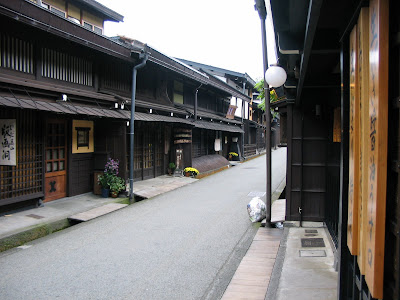Takayama - Old town Japan
Travelling to Takayama from Nikko was a trek but it went smooth as silk. The Nikko Line brought me to Utsunomiya. From there I grabbed the shinkansen to Tokyo and grabbed another to Nagoya. Then I jumped on the line that heads north to Toyama which serves Takayama. This last segment is spectacular as the tracks follow a river north, crossing over it many times. This river has cut a gorge into the rock and is fast flowing enough to be used for hydroelectricity as is evident by the many generation stations I saw. There are also numerous tunnels and, when not buried in one, great views of the mountains. At one point I saw a red torii gate whiz by, feet from the track, marking the entrance of a small shrine.
Takayama is a village of 95,000. It straddles Miya-gawa (Miya River) where it meets Enako-gawa. The entire village is walkable and no sites are more than thirty minutes or so from anywhere else.
Two of Takayama’s main sites are districts that contain houses that are reminiscent of the “old Japan” - the (mouthful!!) Shimoninomachi-ojiinmachi and the Sanmachi Preservation Areas. I am not sure how old the oldest are but they apparently represent the old days of Japan when Takayama-jo (Takayama Castle - built in the late sixteenth century by the Kanamori clan) was still standing on top of the hill in Shiroyama-koen (Shiroyama Park) to the South. The houses are beautiful, constructed of dark brown, almost black, wood and with fine latticework of ocher and ash acting as screens preventing passersby from peeking in. Most of them are two storeys in height. It makes for a very clean, geometric look to a street. As in Nikko, the streets are lined with open culverts though there is no sound of rushing water...at least there wasn’t on the days I was there. The Miya-gawa seems to run very shallow (likely dammed somewhere upriver).
I completed two walks during my stay in Takayama. The first was the 4 kilometre Higashiyama Walking Course to the East. The walk is well marked through the Teramachi District and down to Shiroyama-koen. I began at the northern end of the hills and finished in the park. This area has many temples and this trail goes from one to the next. Apparently these temples were built in the eastern hills of the village to copy the way Kyoto was built, with its main temples in its eastern hills. Along the way I saw persimmon trees, their orange fruits hanging heavily from the branches. The park protects the area where Takayama-jo stood. The guide books mention ruins of the castle but I did not see any during my walk. At the top of the mountain a plaque depicts the layout of the castle as it stood. This park if filled with trails so maybe somewhere in this forested area there are some ruins.
The second walk I did was the Kitayama Walking Course. I started in the (ready?) Shimoninomachi-ojiinmachi Preservation Area and visited the main shrine of the city, the Sakurayama Hachimangu. Again an amazing balance of nature and architecture. The Japanese maples were starting to turn red. The small leaves turn an amazingly bright, fiery red. The trail continues into some hills and gives you wide views of the city’s roofs and the mountains in the distance.


Takayama is a city of narrow streets. At night they are beautifully lit and very peaceful. This village is very quiet in the evenings. As in other places in Japan it feels completely comfortable to be the only person walking down a dark alleyway. You see the faint silhouette of a person up ahead and you just don’t worry. The though doesn’t even cross your mind. I really, really like this about Japan (along with everything else).
View Larger Map
Let me know what you think about what you have just read. Please and thanks!


Takayama is a city of narrow streets. At night they are beautifully lit and very peaceful. This village is very quiet in the evenings. As in other places in Japan it feels completely comfortable to be the only person walking down a dark alleyway. You see the faint silhouette of a person up ahead and you just don’t worry. The though doesn’t even cross your mind. I really, really like this about Japan (along with everything else).
View Larger Map





Comments